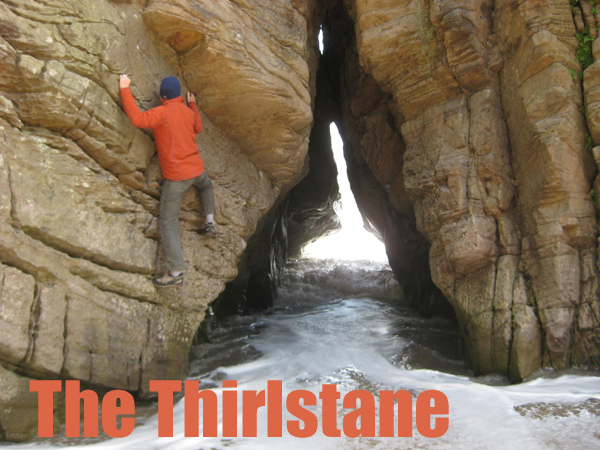
Introduction The Thirlstane is a nice wee crag in Kirkcudbrightshire, on the Solway Coast near Southerness. It is about 20km south of Dumfries. There is a short approach along the beach and nice views from the top over the Solway Firth to the English Lake District. This is a good spot for beginners, bouldering, picnics and families, although there is not a huge amount of route-length climbing.
Access The crag is mostly non-tidal. But at high springs, a few days every two weeks, the cave is flooded for a few hours around 12-2pm, and all routes are affected. Like in the picture above. To get here follow the A710 south from Dumfries, through New Abbey and Kirkbean. Turn off left at the first Southerness sign, then turn left again at the first T-junction and follow the road down to a parking area on the shore just beyond a farmhouse. The crag lies 5 minutes eastwards along the beach
Descent From all routes descend the back of the rock facing the sea, a steep walk. Take care not to fall into the holes at the top of the cave route!
Guidebook For a definitive list of all the climbs and boulder problems at Powillimont see the SMC published Lowland Outcrops guidebook.
Included on this page are a few of the routes at the crag. I climb and instruct regularly at the Thirlstane and have pretty much climbed everything here except the hardest boulder problems.
Dangers This is a friendly wee crag but the rock is soft and the protection is at best unreliable. The area is also frequently used for family picnics, barbecues, etc, so there may well be other people around. Don't drop things from the top of the crag onto peoples heads, and watch out for other people attempting to do the same to you. There is often some loose sand on the climbs and sometimes, occasionally, there is also broken glass.

Further right is a poor Diff up the obvious left leaning ramp, just visible in the above diagram but now very overgrown at the top, and then a reasonable but short V.Diff from behind the old iron fencepost.
This area is frequently used by local outdoor centres, clubs, etc., and many people top-rope the routes. Anchors include, trees, rock flakes, etc., about 3 or 4m back form the edge (and slightly downhill), but they are hard to find if you don't know of them already. Please minimise any damage to vegetation, the big trees will still be needed for belays in the future... Cave Route,brilliant fun but not exactly rock climbing, cannot be effectively top-roped due to the problems of dropping a rope down through the cave, and the huge swing potential of an un-protected second falling off at the 4b crux (which is low on the right as you enter the cave). It might be worth climbing without a helmet as wearing one can result in getting your head jammed in the chock stones.
Goodnight Irene and Zig Zag also have a fairly high swing potential if you try to top-rope them, it is definitely better to have a 2ndd belayer on a back rope.
The wee 6 or 7m high pinnacle (pictured below) makes an excellent venue for practising rope-work, prusiiking, pulleys, self-rescue, etc. It is passed about 30m before the crag on the walk-in. To be fair the short climbs on the steep east face are also pretty good.. wickedly steep Mods and Diffs!

The traverse of the cave mouth is an excellent 4b boulder problem. Below is Lisa Rands on the excellent pocket problem, 5b, which climbs the slab with the prominent circular central pocket (without cheating) that is obvious on the right hand side as you approach the main crag. The photo was taken around about the time she was US Champion, so she flashed it!



